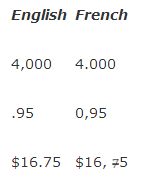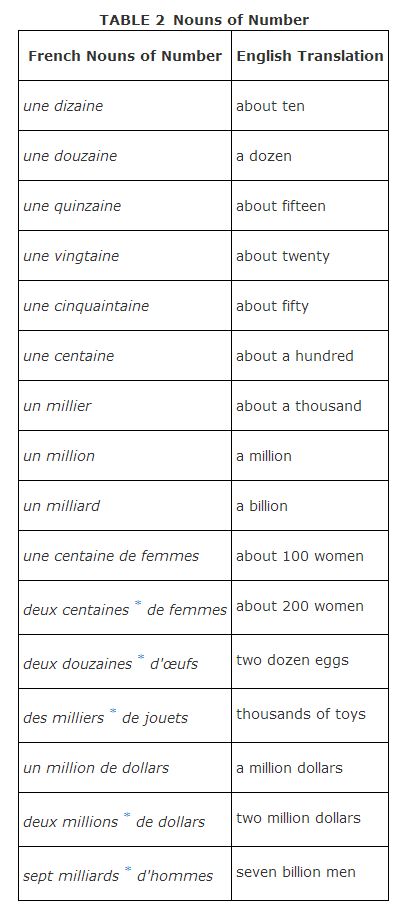The French write two numbers differently than Anericans do: the number 1 has a little hook on top, which makes it look like a 7. So, to distinguish a 1 from a 7, a line is put through the 7, to look like this: 7.
In numerals and decimals, the French use commas where Americans use periods, and vice versa:
|

Cardinal numbers
Consult Table 1 for a list of French cardinal numbers, the numbers we use for counting: 1, 2, 3, 4, and so on.

Note the following about cardinal numbers:
-
The conjunction et (and) is used only for the numbers 21, 31, 41, 51, 61, and 71 . In all other compound numbers through 99, et is dropped, and a hyphen is used.
Before a feminine noun un becomes une.
- vingt et un hommes (21 men)
- vingt et une femmes (21 women)
To form 70 to 79, use soixante plus 10, 11, 12, and so on.
To form 90 to 99, use quatre‐vingt plus 10, 11, 12, and so on.
For quatre‐vingts (80) and the plural of cent (100) for any number above 199, drop the s before another number, but not before a noun .
- quatre‐vingt‐quinze euros (95 euros)
- quatre‐vingts euros (80 euros)
- deux cent cinquante dollars (250 dollars)
- deux cents dollars (200 dollars)
Un is not used before cent (100) and mille (1000).
- cent hommes (100 men)
- mille femmes (1, 000 women)
Mille doesn't take s in the plural .
- deux mille dollars (2, 000 dollars)
Mille becomes mil in dates .
- J'ai mille neuf cent dollars. (I have 1, 900 dollars.)
- Je suis né en mil neuf cents dix. (I was born in 1910.)
To express numbers between 1000 and 9999, where it is more convenient, you can avoid using mille and simply use cent.
- mille cent or onze cents (1, 100)
- mille neuf cents or dix‐neuf cents (1, 900)
The following words are used to express common arithmetic functions.
- + (plus) is et
- − (minus) is moins
- × (times) is fois
- ÷ (divided by) is divisé par
- = (equals) is font
Nouns of number
Some numbers are used as collective nouns to express a round number, and some are followed by de (d') before another noun, as shown in Table 2.

Ordinal numbers
Ordinal numbers allow you to express the floors in a building or numbers in a series. Most ordinal numbers are formed by adding i‐ème to the cardinal number, as shown in Table 3.

Note the following about ordinal numbers:
Premier and première are abbreviated as follows:
- premier: 1 er
- première: 1 re
All other ordinals get a superscript, e, as follows:
- dixième: 10e
- centième: 100e
Except for premier and second, ordinal numbers are formed by adding -ième to the cardinal number. The silent e is dropped before - ième:quatrième, onzième, and so on.
- la quatrième fois (the fourth time)
A u is added in cinquième, and a v replaces the f in neuvième.
- le cinquième chapitre (the fifth chapter)
Ordinal numbers agree in number and gender with the nouns they descibe. Premier (première) and second (seconde) and numbers using unième (uneième) are the only ordinal numbers that have a feminine form.le premier garçon (the first boy)
- la première fille (the first girl)
- les premières années (the first years)
- les vingt et unièmes anniversaires (21st birthdays)
Premier is used only for the first in a series. For 21 to 71, unième is added after the conjunction et to express first, and it must agree in number and gender with the noun it modifies.le cinquante et unième match (the 51st match)
- la quarante et uneième année (the 41st year)
- Second(e) is generally used in a series that goes no higher than two.
Use le or la before huit/ huitième and onze/ onzième. No elision is necessary.le huitième jour (the 8th day)
- le onze juillet (July 11th)
In French, cardinal numbers precede ordinal numbers.
- les quatre premières personnes (the first four people)